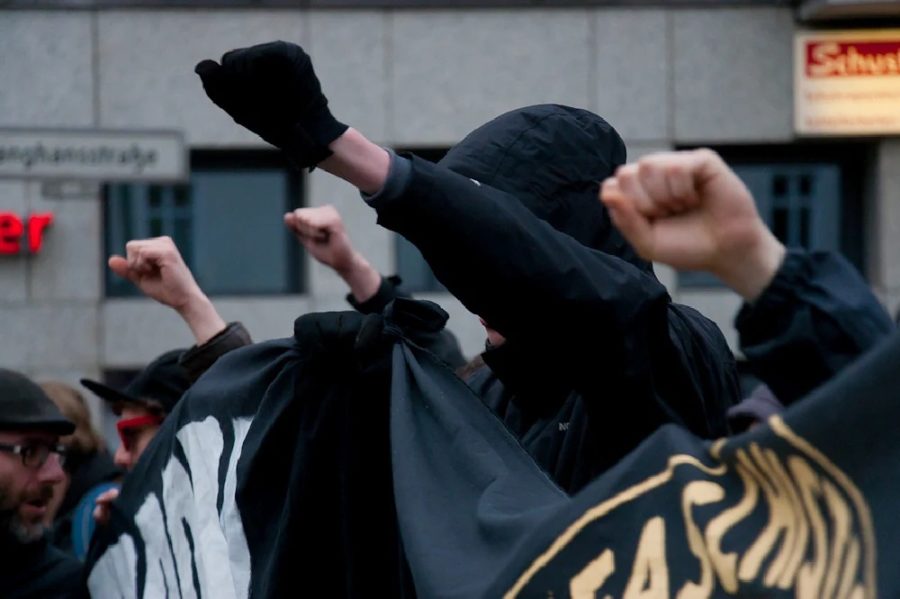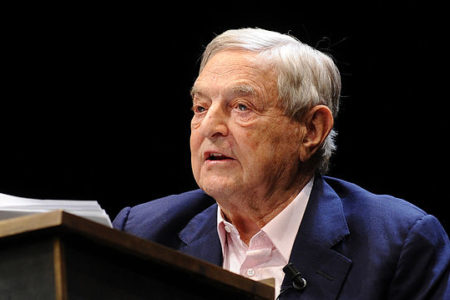
In the immediate aftermath of the Charlottesville violence, several prominent figures—including CNN anchor Chris Cuomo and Jeffrey Goldberg, editor-in-chief of The Atlantic—equated left-wing “Antifa” activists with the thousands of Allied soldiers who stormed Normandy’s beaches to invade Adolph Hitler’s “Fortress Europe” on D-Day.
A more appropriate equation would be with the thousands of soldiers in the Red Army, who brutally marched toward Berlin, where they would establish Soviet hegemony in the so-called German Democratic Republic after defeating Hitler.
Antifa returns to the news this week. On Tuesday night, former Breitbart.com editor Milo Yiannopoulos spoke at California State University, Fullerton in a program sponsored by that university’s College Republicans. Seven were arrested amid reports of head-punching and pepper-spraying. Protesters of the event chanted “Cops and the Klan go hand in hand!” and held signs reading “Only socialist revolution can defeat capitalist reaction.” In February, Antifa militants committed such mayhem while protesting Yiannopoulos’ appearance at the University of California at Berkeley that university officials cancelled his speech at the last minute.
On Saturday, Antifa will join other leftist groups in massive nationwide protests designed to force President Donald Trump’s administration out of office. Organizing those protests is “Refuse Fascism,” which declares that “in the name of humanity, we REFUSE to accept a Fascist America!”
Despite antiseptic portrayals throughout American media, Antifa are more than “anti-fascists.” Antifa represent the chaos of Germany’s Weimar Republic and provide the violent complement to academic neo-Marxism. Like their philosophical comrades, Antifa seek to destroy the American emphasis on liberty under law and to impose a revival of one of history’s most repressive ideologies.
Antifa Is Anti-West and Anti-Capitalist
Bernd Langer, whose “80 Years of Anti-Fascist Action” was published by Germany’s Association for the Promotion of Anti-Fascist Literature, succinctly defined the rhetorical subterfuge. “Anti-fascism is a strategy rather than an ideology,” wrote Langer, a former Antifa member, for “an anti-capitalist form of struggle.”
Short for the German phrase, “Antifaschistische Aktion,” Antifa served as the paramilitary arm of the German Communist Party (KPD), which the Soviet Union funded. In other words, Antifa became the German Communists’ version of the Nazis’ brown-shirted SA.
The KPD made no secret of Antifa’s affiliation. A 1932 photo of KPD headquarters in Berlin prominently displayed the double-flagged Antifa emblem among other Communist symbols and slogans. In a photo from the 1932 Unity Congress of Antifa in Berlin, the double-flagged banner shared space with the hammer and sickle and with two large cartoons. One supported the KPD, the other mocked the SPD, Germany’s Social Democratic Party.
Today’s Antifa embrace those roots. During February’s protest in Berkeley, masked Antifa agitators caused nearly $100,000 in damage by starting fires, breaking windows, assaulting bystanders with pepper spray and flagpoles, painting graffiti on nearby businesses, and destroying automatic teller machines. “Refuse Fascism,” the group organizing Saturday’s protests, is controlled by the Revolutionary Communist Party USA, which seeks to create a Marxist United States through violent revolution.
Law and Order Are Among Antifa’s Enemies
Antifa’s goal to suppress “fascism” reflects the views of neo-Marxist philosopher Herbert Marcuse. “A policy of unequal treatment would protect radicalism on the Left against that on the Right,” Marcuse wrote in “Repressive Tolerance,” his 1965 essay. “Liberating tolerance, then, would mean intolerance against movements from the Right and toleration of movements from the Left” extending “to the stage of action as well as of discussion and propaganda, of deed as well as of word.”
Marcuse dismissed the idea of individual liberty protected by law in favor of a Marxist society favoring ostensibly oppressed groups at the expense of everybody else. Such a society, Marcuse wrote, would demand “the withdrawal of toleration of speech and assembly from groups and movements” that not only “promote aggressive policies, armament, chauvinism, discrimination on the grounds of race and religion” but also “oppose the extension of public services, social security, medical care, etc.” and “may necessitate new and rigid restrictions on teachings and practices in the educational institutions.”
Marcuse even justified violence: “there is a ‘natural right’ of resistance for oppressed and overpowered minorities to use extralegal means if the legal ones have proved to be inadequate,” Marcuse wrote. “Law and order are always and everywhere the law and order which protect the established hierarchy; it is nonsensical to invoke the absolute authority of this law and this order against those who suffer from it and struggle against it … for their share of humanity. If they use violence, they do not start a new chain of violence but try to break an established one.”
In expressing his contempt for “the sacred liberalistic principle of equality for ‘the other side,’” Marcuse maintained in 1968 ”that there are issues where either there is no ‘other side’ in any more than a formalistic sense, or where ‘the other side’ is demonstrably ‘regressive’ and impedes possible improvement of the human condition.”
Elements of Today’s Left Embrace Marcuse’s Ideas
K-Su Park, a University of California at Los Angeles law fellow, reflected Marcuse’s thought when in an op-ed in The New York Times she challenged the American Civil Liberties Union to reconsider its approach to the First Amendment. The ACLU represented Jason Kessler, who organized the “Unite The Right” rally and sued the City of Charlottesville for revoking his permit for the protest.
The ACLU’s approach “implies that the country is on a level playing field, that at some point it overcame its history of racial discrimination to achieve a real democracy, the cornerstone of which is freedom of expression,” Park wrote. “Other forms of structural discrimination and violence also restrict the exercise of speech, such as police intimidation of African-Americans and Latinos. The danger that communities face because of their speech isn’t equal.”
Park’s fellowship is with UCLA’s critical race studies program. Critical race studies comes from critical theory, a sociological approach developed by Germany’s neo-Marxist Frankfurt School, where Marcuse was a leading thinker. Johns Hopkins professor N.D.B. Connolly blended Marcuse’s philosophy with Antifa’s militancy in a Washington Post op-ed, where he compared the United States’ racial history to a game of rock-paper-scissors.
“For a long while, we’ve been throwing a lot of ‘paper,’” Connolly wrote. “Liberalism — our paper — preserves our country’s long commitment to contracts. Under liberalism, citizens stand in contract with their government. The government’s job, in turn, has been to enforce contracts between individuals and groups. Truly, when people ask for rights, be they women’s rights, gay and transgender rights, or rights as people of color, they are asking for contract rights.”
‘Rock Breaks Scissors’
But racism, Connolly argued, serves as scissors: “Right at the country’s founding, racists cut black and indigenous people out of liberalism’s contract. Black bodies and Native American land did not deserve the protection of contract. They deserved bondage and expropriation.”
The solution? “No matter its form, rock breaks scissors,” Connolly wrote. “A half-century ago, nothing less than radical anti-racism could reduce white supremacy to an outlaw religion. … In April 1968, amid a flurry of other ‘rocks,’ riots shook American cities following the assassination of Martin Luther King Jr. It took that rolling unrest … to spur President Lyndon Johnson and Congress to action. Within a week they had passed the Fair Housing Act.”
Connolly concluded by advocating similar measures. “Segregationists have again assumed their pedestals in the Justice Department, the White House and many other American temples,” he wrote. ”Paper alone won’t drive them out. Start throwing rocks.” In slandering those who hold opposing views, and in essentially calling Martin Luther King Jr. a failure, Connolly reflected the true “Antifa” spirit: Neo-Marxism über alles.
via The Federalist






Jim
Antifa lives by the sword and will die by the sword, they don’t bother to know the truth: Greek humanism always devours its’ offspring.